TIZ 2. Writing With No Idea
- Encounter
- Seminars and Lectures
- Workshop
- Guided Tour
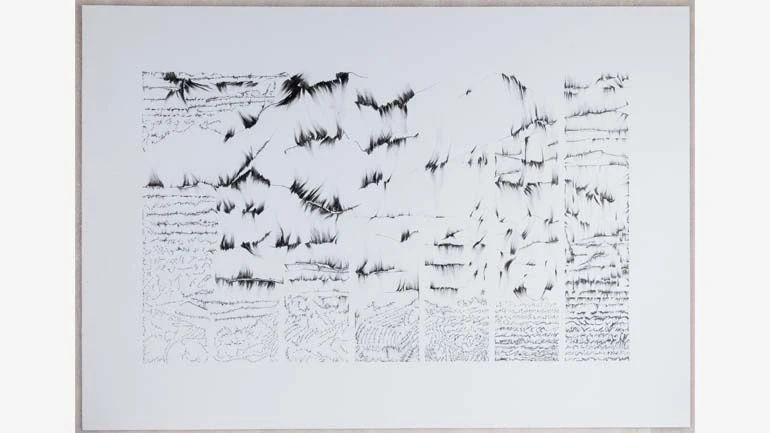
Held on 01 Apr 2022
This spring, different forms of reading, writing practices and literature gain prominence in the Museo with a second Temporary Intensity Zone (TIZ) opening under the title, aligned with the ideas of poet and historian Ángel González, Escribir sin tener ni idea (Writing With No Idea).
González asserted that art works autonomously from the art theory that attempts to explain it: thus, art is “knowledge that knows as long as it is doing”, but “not what it is saying”. Consequently, “writing with no idea” refers to writing that knows but at the same time does not know and serves different users and people working with literature. Through different textual practices, in the chasm of words or in the Möbius strip that unfolds before the world, “writing with no idea” can entail “writing well”, even very well, but also “writing against”. Thus, “idealess writing” is writing situated in reality before Literature with a capital L and is woven in the loom of many flows of meaning that traverses all language, opposite its privatisation at the service of norms, classes, technocracies and interests.
Writing With No Idea looks to explore how words, narrative, can expand beyond literature and towards new territories of artistic creation and reflection of thought in the contemporary world.
-
Friday, 22 April 2022 Nouvel Building, Library and Documentation Centre
Book Night
A Library for the XYZ Century
RegistrationThis workshop for families with children aged between 6 and 12 travels through, analyses and plays with the Library’s architecture, the work of French architect Jean Nouvel, which is presented as a haven of peace amid the hubbub of Madrid. Children and adults will closely examine and gaze, architecturally, at the building, observing from another point of view, from experimentation and play. The tour ends with a collective construction of scale models to imagine the ideal library in the 21st century, in accordance with the current needs of users (adults and youngsters).
Organised by: Museo Reina Sofía
Collaboration: Chiquitectos and AMECUM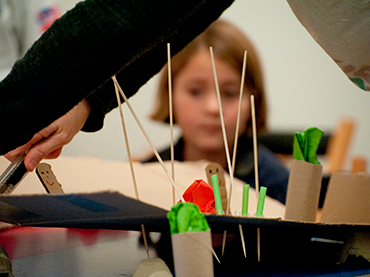
-
Tuesday, 26 April 2022 Meeting point: Sabatini Building, Floor 2, Room 201.01
Free Unions. Avant-garde Gatherings
Activities about the Collection
RegistrationFree Unions is a series of events, tours and activations that take place in the rooms of Communicating Vessels. Collection 1881–2021, the new rehang of the Museo Reina Sofía Collection. The programme is made up of different thematic strands, the title based on the poem Free Union (1931) by André Breton in its definition of psychic automatism as an alternative to rationalism. The transgressive spirit of that poem, which takes apart rational discourse through a lexical juxtaposition to generate other relationships and significations, governs this public programme, in which recitals, readings, debates, performances and actions in these rooms transgress the aura of the white cube.
The first of these events, Avant-garde Gatherings, is activated in rooms 201.01, 201.02 and 201.03. Holy Bohemia. Madrid, Paris, Barcelona, Room 202.03. Stridentopolis. An Urban Utopia and Room 203.01. Madrid, a Diverse City in which fin de siècle cuplés and a series of machine-like, phonetic sound concerts on these avant-garde movements are performed.
Organised by: Museo Reina Sofía
-
Saturday, 30 April 2022 Nouvel Building, Library and Documentation Centre
Look Closely. Photobook
Four-Colour Process Mediation Around the Library’s Photobook Collection
RegistrationThis activity puts forward a mediation device around the collection of photobooks, addressing questions that include: What do the works in the Museo and the Library have in common? What are the connections between customary publications and artistic ones? What can a museum’s library learn from a local newsstand? And what similarities do Roy Lichtenstein’s works and HELLO! magazine share? These questions are all set out in a morning workshop — split into three different access groups — in which, via four seasons based on the principles of four-colour process printing, attendees will explore the origins of this discipline and its foremost creators.
Organised by: Museo Reina Sofía
Collaboration: Colectivo HUL -
From 11 to 16 May 2022 Museo Reina Sofía (Madrid), Centro de Arte José Guerrero and La Madraza (Granada)
Documents 21
Kenneth Goldsmith: An Archive Can Be Anywhere
TicketsThis new edition of the Documents programme welcomes poet, artist and editor Kenneth Goldsmith. Goldsmith, an archive theorist, a poet in the sphere of “non-creative writing” — a concept based on plagiarism, appropriation and the non-subjective use of literature — and the creator of the digital platform ubuweb, a paradigm of the immaterial museum of modern and contemporary art, will give a lecture on the history and challenges of this platform, a workshop on radical archive practices in the Museo Reina Sofía, and a second workshop on “non-creative writing” in the Centro de Arte José Guerrero and La Madraza.
Organised by: Museo Reina Sofía, Centro de Arte José Guerrero and La Madraza. Centro de cultura contemporánea de la Universidad de Granada
-
Friday, 13 May 2022 Sabatini Building, Auditorium and online platform
The Atlantic Underground Experience
Forty Years of the Rompente Collective (1975–1983)
TicketsThrough the paths leading from Marxism-Leninism and the fight for national liberation to pop culture — with or against post-modern banality, denying or desiring the local evolution of Madrid’s Movida cultural movement — the experience of the Rompente collective in Galicia during the Transition to democracy is articulated here. Fanzines, gatherings, verses, performances, collages, concerts, video clips and vinyl records shape a sprawling poetic-political archive. Four decades on from the collective’s disbandment, the historical meaning of this community of artists, poets, musicians and likeminded figures is reflected and worked upon in an encounter, focusing on its memory, forms of artistic production and political by-products. In the voices of its leading figures and witnesses, and via the perspectives of younger poets, critics and researchers, a collective journey is set forth around the world of the Atlantic underground in the 1970s and 1980s, the echoes and forms of which still interrogate us from the seas of Vigo.
Organised by: Museo Reina Sofía
-
Saturday, 14 May 2022 Nouvel Building, Auditorium 200 and online platform
Bioliteratures 1
The Writing and Imagery of Rafael Chirbes
TicketsBioliterature is conceived as a series of sessions in which writing forms converge around authors whose careers defy distances between subjects and language, between the self and us, between the public and the private. For this first session, the literary work of Rafael Chirbes, which speaks to us of disarticulated and violent nature intrinsically constituting our times, has been selected. The memory of repression, the dignity of poverty, the suppression of memory, the marks of class on the body, crossed interests and desires, literary history as an alternative national history, polyphony as a factory of subjectivity and construction as a poetic legacy for a future democracy are themes which, from Chirbes’s literary world, still interrogate us.
Organised by: Museo Reina Sofía

-
Alternate Wednesdays until 29 June 2022 Nouvel Building, Library and Documentation Centre
Other Books and So
Reading Club
RegistrationTaking as its reference point the project founded in 1975 by Ulises Carrión, Other Books and So, one of the world’s first bookshops of artists’ publications, this reading club is an initiative open to every type of public and is held within the context of the Museo and scores of actions on contrasting scales — by turns interwoven and distant. A literary proposal that looks to circulate through the Museo transversally, with a view to grasping it from different gazes, questioning, inhabiting and accompanying it in its changes. That is: understanding the book not only as a literary possibility, but also an historical, artistic, social, political and exhibition possibility, and creating a space so between us we can evolve in the process. The programme comprises four interconnected blocks that explore different themes from four publications and includes different activities, gatherings and activations.
Coordinated by: Alberto Medina and Daniel Pecharromán
Organised by: Museo Reina Sofía
Collaboration: Asociación de Mediadoras de la Comunidad de Madrid (AMECUM) -
Mondays and Wednesdays until June 2022 Sabatini Building, Workshops
Spanish Language School for the Migrant Population
Live to See. See to Live
RegistrationMuseo Reina Sofía joins up with Red Interlavapiés (The Interlavapiés Network) to organise a small Spanish Language School for migrant residents in the Community of Madrid who require knowledge and use of the local language as a tool for day-to-day communication, work and involvement in society.
The classes take place in two constantly alternating spaces: the workshop spaces and the rooms of the Museo Reina Sofía Collection, where a direct dialogue is struck up with the works on display, giving rise to subjects related to daily life which are worked upon in the different sessions — intersections resulting in a creative personal experience combining image and word (oral or written).
Coordinated by: Red Interlapaviés
Organised by: Museo Situado
-
Every Tuesday, from 5 April to 31 May 2022 (except 12 April) Nouvel Building, Floor 3, Education Area
Listen Up: A Contemporary Challenge
Reading Workshop with Amador Fernández-Savater
RegistrationIn recent years, the widespread perception of time speeding up has become apparent, and we commonly note problems with or a lack of concentration, attention deficit in children and having to resort to medication and therapies to “stop our minds” and to learn to live in the here-and-now. What is happening to our attention span?
In The School of Listening, the Museo’s training programme for teachers, a workshop coordinated by Amador Fernández-Savater puts forward a space of conversation based on the shared reading of a selection of texts that approach the contemporary problem of attention from different fronts, including childhood, care, philosophy, psychology, science, teaching, art and politics. Reading and conversation, experiences which, in their own right, are practices of intimate and relational attention.
Organised by: Museo Reina Sofia
-
Episode 1. Avant-garde Territories: City, Architecture and Magazines Sabatini Building, Floor 2
Madrid, A Diverse City. Room 203.01
At the dawn of the twentieth century, Spain was enmeshed in the crisis of ’98, its political class agreeing to remain neutral in the First World War. This neutrality brought with it economic development and Barcelona and Madrid strengthened their relations in Europe, taking on a renewed cosmopolitan demeanour. Madrid welcomed international artists fleeing from the war, helping to create a heterogenous group of creators who, accustomed to working on multi-disciplinary projects, would end up shaping the ultraist experience. Madrid’s cafés thus became spaces of sociability and cultural transformation as different gatherings sprouted around figures such as Rafael Cansinos Asséns and Ramon Gómez de la Serna.
-
Episode 1. Avant-garde Territories: City, Architecture and Magazines Sabatini Building, Floor 2
The Documents Magazine. Room 206.02
The Documents magazine, edited by Georges Bataille, brought together contributors to Surrealist dissidence such as Robert Desnos, Michel Leiris, André Masson and Joan Miró, along with experts in ethnography, numismatics, jazz and archaeology. The room assembles works by some of the people who contributed to the magazine, which was famous for the way it used different forms of montage and the association between image and text; the magazines that bound together Surrealism are constituent of the total action of the movement. Documents was published in Paris in 1929 and 1930 and comprises 15 issues characterised by the relationships these editions established between art-making and contemporary theory in different areas. The artists that contributed to the magazine operated outside official circles, as established by André Bretón, and the publication played a crucial role in this respect, becoming a stage for dissident Surrealism.
-
Episode 2. The Lost Thought Sabatini Building, Floor 4
Max Aub: Blind Man’s Bluff, 1971. Room 423
This room assembles works that revolve around the figure of Max Aub (1903–1972), whose literary talent and political commitment turned him into a reference point beyond question in 1920s and 1930s Spain. After the Spanish Civil War broke out, Aub joined the Alliance of Anti-Fascist Writers for the Defence of Culture from Madrid, was a cultural attaché to the Spanish Embassy in Paris and, appointed by the Ministry of Public Education and Fine Arts, was a member of the Delegated Commission for Spain’s cultural expansion abroad. Also a friend of painters such as Josep Renau and an active agent in the Guernica commission for the Spanish Pavilion at the 1937 World’s Fair in Paris, Aub embarked upon a series of novels entitled El laberinto mágico (The Magic Labyrinth) in 1939, the year of his exile, narrating the experience of the Civil War and the internment camps. He returned to Spain in 1969, to a country that contrasted sharply with the one he had left behind and imagined during his exile, as expressed in the pages of the diary La gallina ciega (Blind Man’s Bluff, 1971).
-
Episode 3. Campo Cerrado Sabatini Building, Floor 4
The “Frivolous” Avant-garde in the Post-war Era. Room 400.04
A climate of fear accompanied by scarcity and hardship settled in the post-war period. Opposite a more traditional reading of this era, centred on the study of official events or the existence of influential cultural groups, such as the salons of Eugeni d’Ors, the emotional, affective, economic and social climate of the time is invoked by assembling highly divergent materials, crossing, transversally, “high” and “low” culture. Furthermore, it shows the subversive potential of humour which, as the curator Mery Cuesta recalls, became instrumental to avant-garde movements to fight against social conventions, encompassing theatre (with Francisco Nieva), film (with Edgar Neville) and the publishing world (with the publication La Codorniz). On display in this room are some of Enrique Herreros’s covers for this publication, as well as the series of prints La tauromaquia de la muerte (Bullfighting of Death, 1946).
-
Episode 5. Enemies of Poetry: Resistance in Latin America Sabatini Building, Floor 4
Pense-Bête. Artists and Poets. Room 432
The vindication of reality that got under way in the late 1950s led to a more radical challenge to notions of artwork and authorship, placing value on the poetics of the process and the objectual nature of the work. Inside this context, artworks became footprints of a broader poetic universe and forms of expression such as those by Marcel Broodthaers, who, to symbolically mark his move from poetry to visual arts, set fifty unsold copies of his book of poems Pense-Bête in plaster to create the piece that lends the room its title. The “death of the author” was the term thinkers Roland Barthes and Michel Foucault gave to a process of demythologising the figure of the artist — opposite this figure self-absorbed in genius, artists tested self-critical, poetic and ironical strategies: happenings, wordplays and a vindication of the everyday were some of their new resources.
-
Until 10 June 2022 Nouvel Building, Library and Documentation Centre, Space D
ilimit
Isidoro Valcárcel Medina
Isidoro Valcárcel Medina (Murcia, 1937) is one of the pre-eminent representatives of Spanish conceptual art. His body of work, with its committed stance and far removed from art’s commercial side, cannot be placed easily in customary exhibition spaces and contexts. This exhibition focuses on one of the mediums he has used more extensively in his investigations: the book and publishing format. Many of his reflections around the book concept are evinced in his work ilimit, created in 2012 for the publishing and art space Ivorypress, in a nine-volume edition with two artist’s proofs, and displayed in this documentary show. The work explores the contrast between the concepts of limited and unlimited as it sets forth a reflection around the terms seriation and exclusiveness, both frequent in the art world. The work is joined by different archive documents which afford greater depth in the project and in the conceptual process that shapes this creation.
Organised by: Museo Reina Sofía
Collaboration: Ivorypress
-
Every Friday Meeting Point: Sabatini Building, Floor 1, Education desk
Leaving the Margin. The Exile of the Wanderer
Visits for Adults Around Works from the Collection
TicketsLeaving the Margin sets forth a new way of approaching the Museo Reina Sofía Collection via a selection of readings taken from the holdings housed in the Museo’s Library and Documentation Centre. Under this transversal gaze, the document not only plays a key role in understanding the historical-artistic context, but also takes on additional value through dialogue and a comparison with other pieces in the Museo. To carry out this first “read” tour, it takes Episode 2. The Lost Thought as its point of departure (Sabatini Building. Floor 4), placing the focus on the Republican exile sparked by the victory of the Nationalist Faction during the Spanish Civil War.
-
Last Thursday of each month Nouvel Building, Library and Documentation Centre
Magnetised Needle. Walking the Page
Visits for Adults Around the Library and Documentation Centre
Check timesThe Museo Reina Sofía Library and Documentation Centre is a study and research centre specialised in contemporary art that conserves a major artistic and documentary archive, its significant holdings housed in a building of unique beauty, designed by French architect Jean Nouvel. This tour offers the chance to discover its facilities, the history of the institution, its roles and the services it renders. It also presents a selection of relevant bibliographic and documentary holdings (printouts, ephemera, photobooks, artists’ books, ancient holdings, etc.).
-
Fridays, until 10 June Nouvel Building, Library and Documentation Centre
Magnetised Needle. ilimit
Visits for Adults Around the Documentary Show
Check timesThese guided tours around the documentary show ilimit seek to delve into the work carried out by Isidoro Valcárcel Medina around the book concept understood as an artistic practice. His work in this field has not only focused on analysing this object in its formal and material dimension, attempting to pass through the limits and ideas traditionally associated with these objects, but also to recognise its importance in transmitting ideas and knowledge.
-
EPUB
what about support and what about struggle
Read EPUBPublished by L'Internationale Online and edited by Jennifer Hayashida and Corina Oprea, this digital publication is a collection of poetic responses to one of today’s most pressing issues: How do we survive unnatural disasters? Starting from a collective reading of Francis Marie Lo’s poetry book A Series of Un/Natural/Disasters(Commune Editions, 2016), the poets and artists Lukaza Branfman-Verissimo, Léuli Eshrāghi, Fernanda Laguna, Napo Masheane, tacoderaya and Merve Ünsal have resituated their critique of catastrophic discourse in other urgent pasts and presents through different poetic, visual, discursive and sound formats. What are the poetics we are left with when the unnatural entanglements of “disaster” are taken apart and reconstructed?
Organised by: L’Internationale
Inside the framework of: Our Many Europes
Más actividades

Difficulty. Forms and Political Effects of Deviation in Writing and Contemporary Art
23 February – 14 December 2026 – Check programme
Difficulty. Forms and Political Effects of Deviation in Writing and Contemporary Art is a study group aligned towards thinking about how certain contemporary artistic and cultural practices resist the referentiality that dominates the logics of production and the consumption of present-day art. At the centre of this proposal are the concepts of difficulty and deviation, under which it brings together any procedure capable of preventing artistic forms from being absorbed by a meaning that appears previous to and independent from its expression. By ensuring the perceptibility of their languages, difficulty invites us to think of meaning as the effect of a signifying tension; that is, as a productive and creative activity which, from the materiality of art objects, frees aesthetic experience from the representational mandate and those who participate in it from the passiveness associated with tasks of mimesis and decoding.
The economy of the referential norm translates the social logic of capitalism, where insidious forms of capturing subjectivity and meaning operate. In the early 1980s, and adopting a Marxist framework, poet Ron Silliman highlighted how this logic entailed separating language from any mark, gesture, script, form or syntax that might link it to the conditions of its production, rendering it fetichised (as if without a subject) and alienating its users in a use for which they are not responsible. This double dispossession encodes the political strategy of referential objectivity: with no subject and no trace of its own consistency, language is merely an object, that reality in which it disappears.
The political uses of referentiality, more sophisticated today than ever before, sustain the neoliberal-extractivist phase of capitalism that crosses through present-day societies politically, economically and aesthetically. Against them, fugitive artistic practices emerge which, drawing from Black and Queer studies and other subaltern critical positions, reject the objective limits of what exists, invent forms to name what lies outside what has already been named, and return to subjects the capacity to participate in processes of emission and interpretation.
Read from the standpoint of artistic work, the objective capture of referentiality may be called transparency. Viewed from a social contract that reproduces inequality in fixed identity positions, transparent in this objectivity are, precisely, the discourses that maintain the status quo of domination. Opposite the inferno of these discourses, this group aims to collectively explore, through deviant or fugitive works, the paradise of language that Monique Wittig encountered in the estranged practices of literature. For the political potency of difficulty — that is, its contribution to the utopia of a free language among equals — depends on making visible, first, its own deviations; from there, the norm that those deviations transgress; and finally, the narrowness of a norm which in no way exhausts the possibilities ofsaying, signifying, referring and producing a world.
From this denouncement of referential alienation, fetishisation and capture, Difficulty. Forms and Political Effects of Deviation in Writing and Contemporary Art turns its attention to the strategies of resistance deployed by contemporary artists and poets. Its interest is directed towards proposals as evidently difficult or evasive as those of Gertrude Stein, Lyn Hejinian, Theresa Hak Kyung Cha, Kameelah Janan Rasheed, Kathy Acker, María Salgado and Ricardo Carreira, and as seemingly simple as those of Fernanda Laguna, Felix Gonzalez Torres and Cecilia Vicuña, among other examples that can be added according to the desires and dynamics of the group.
The ten study group sessions, held between February and December, combine theoretical seminars, work with artworks from the Museo Reina Sofía’s Collections and exhibitions, reading workshops and public programs. All these formats serve as spaces of encounter to think commonly about certain problems of poetics — that is, certain political questions — of contemporary writing and art.
Difficulty. Forms and Political Effects of Deviation in Writing and Contemporary Art inaugurates the research line Goodbye, Representation, through which the Museo Reina Sofía’s Studies Directorship seeks to explore the emergence of contemporary artistic and cultural practices which move away from representation as a dominant aesthetic-political strategy and redirect their attention toward artistic languages that question the tendency to point, name and fix, advocating instead for fugitive aesthetics. Over its three-year duration, this research line materializes in study groups, seminars, screenings and other forms of public programming.

CLINIC 2628. A Community of Writing and Research in the Arts
February – October 2026
Clinic 2628 is a project which supports and brings together writings which stem from the intention to offer a space and sustainable time for research work in art and culture. Framed within an academic context which is increasingly less receptive to the forms in which thinking happens and is expressed, the aim is to rescue the academic from its neoliberal trappings and thus recover the alliance between precision and intuition, work and desire. A further goal is to return writing to a commons which makes this possible through the monitoring of processes and the collectivisation of ideas, stances, references and strategies.
The endeavour, rooted in a collaboration between the Museo Reina Sofía’s Studies Directorship and the Artea research group, via the i+D Experimenta project, is shaped by three annual editions conceived as spaces of experimentation, discussion and a demonstration of writings critical of what is put forward by today’s academia.
What forces, forms and processes are at play when writing about art and aesthetics? In academia, in museums and in other cultural institutions, the practice of writing is traversed by productivist logics which jeopardise rhythms of research and experimentation. The imposition of both scientism inherent in the structure of “the paper” and the quantifying of results which demand a criterion of quality and visibility sterilise and smoothen, from the outset, the coarseness that is particular to writing understood from the concrete part of language: phonic, graphic, syntactic and grammatical resistance connecting the language user to the community the language unites and activates. They also sterilise the roughness enmeshed in the same desire to write, the intuitive, clear and confusing pathways that once again connect the writer to those reading and writing, participating in a common good that is at once discovered and produced.
The progressive commercialisation of knowledge propelled by cognitive capitalism moves further away from the research and production of knowledge in artworks and artistic languages and practices. The work of curators and archive, criticism, performances and essays formerly saw a horizon of formal and emotional possibilities, of imagination that was much broader when not developed in circumstances of competition, indexing and impact. Today, would it be possible to regain, critically not nostalgically, these ways; namely, recovering by forms, and by written forms, the proximity between art thinking and its objects? How to write in another way, to another rhythm, with no more demands than those with which an artwork moves towards different ways of seeing, reading and being in the world?
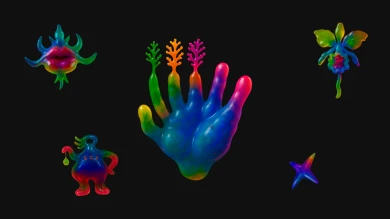
Cultural Work
Thursday, 12 February 2026 – 5:30pm
This series is organised by equipoMotor, a group of teenagers, young people and older people who have participated in the Museo Reina Sofía’s previous community education projects, and is structured around four themed blocks that pivot on the monstrous.
Session number two looks to approach film as a place from which cultural work is made visible and processes of production engage in dialogue with artistic creation. From this premise, the session focuses on exploring how audiovisual content is produced, assembled and distributed, from the hands that handle the images to the bodies that participate in its circulation. The aim is to reflect on the invisible effort, precarity and forms of collaboration that uphold cultural life, that transform the filmic experience into an act that recognises and cares for common work.
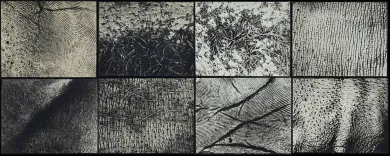
The (legal) person and the legal form. Chapter II
8, 12, 15 January, 2026 – 16:00 to 19:00
As part of the Studies Constellation, the Study Directoship’s annual fellowship, art historian and theorist Sven Lütticken leads the seminar The (Legal) Person and the Legal Form: Theoretical, Artistic, and Activist Commitments to foster dialogue and deepen the hypotheses and questions driving his research project.
This project, titled Unacting Personhood, Deforming Legal Abstraction, explores the dominance of real abstractions—such as exchange value and legal form—over our processes of subjectivation, and asks how artistic practices can open up alternative ways of representing or performing the subject and their legal condition in the contemporary world.
The seminar consists of eight sessions, divided into three chapters throughout the academic year. While conceived as non-public spaces for discussion and collective work, these sessions complement, nourish, and amplify the public program of the Studies Constellation.
In this second chapter of the seminar, the inquiry into the aesthetics and politics of legal form continues with three sessions that pick up the discussions held in Chapter I but propose new lines of flight. The first session focuses on international law via the writings of the British author China Miéville, which allows us to reconsider the notion of the legal form –following Evgeny Pashukanis— and, through it, a variety of (people’s) tribunals. While the crucial concept of the legal person –as the right-holder central to the form of law— was debated in Chapter I, the second session focuses on attempts to extend personhood not (just) to corporations, but rather to nonhuman animals or ecosystems. Finally, the third session poses the question: how can groups and networks use officially recognized organizational forms (such as the foundation or the cooperative) and/or use a collective persona (without necessarily a legal “infrastructure” to match) to act and represent themselves?

TEJA 2026. Open Call for Emergency Art Residencies
Proposal submission until 12 January, 2026
TEJA / Red de espacios culturales en apoyo a situaciones de emergencia [Network of Cultural Spaces in Support of Emergency Situations] has the mission to promote transnational cooperation by offering temporary art residencies to artists and cultural practitioners who find themselves in complex socio-political situations in their countries of origin. During their stay in Spain, residents receive accommodation, legal and psychological counseling, and access to a network of organizations and professionals with whom they can share, develop, and continue with their creative projects. The goal is to provide a safe and stimulating environment where artists can continue their work despite adverse circumstances and generate dialogue spaces that ensure freedom of expression through joint activities both in Spain and with international collaborators.
During 2026, TEJA hosts three new residencies, each lasting three months, dedicated to supporting artists and cultural practitioners residing in the West Bank and Jerusalem. In addition, in the second half of the year, TEJA hosts three additional residencies for Gazan artists, which are offered by invitation (as Spain is currently unable to facilitate evacuations from Gaza, these invitations are coordinated through France). These residencies aim to provide a stable, creative environment and foster artistic exchange in the face of ongoing adversities. Through this new program, TEJA reaffirms its commitment to amplifying Palestinian voices and empowering artists as they navigate these turbulent times.
The selection is carried out by the TEJA network in close collaboration with each hosting partner. This year the hosting partners are: La Escocesa (Barcelona), hablarenarte / Planta Alta (Madrid), Espositivo (Madrid), Institute for Postnatural Studies (Madrid), Casa Árabe (Córdoba). The selection prioritizes the artist’s personal and professional situation first, and then the alignment with the practices and themes of the hosting spaces. Proposal submission deadline is January 12th, 2026, 23:59 h.
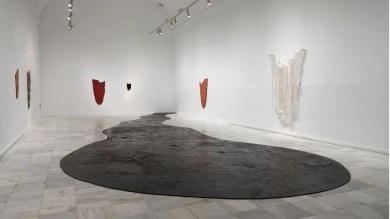
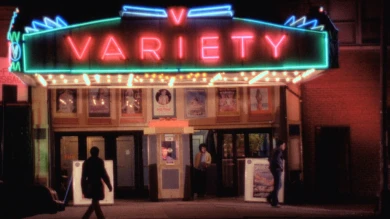
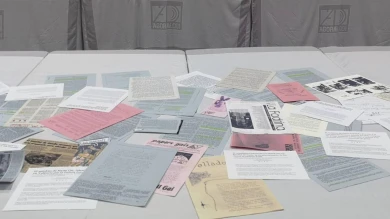
![Miguel Brieva, ilustración de la novela infantil Manuela y los Cakirukos (Reservoir Books, 2022) [izquierda] y Cibeles no conduzcas, 2023 [derecha]. Cortesía del artista](https://recursos.museoreinasofia.es/styles/small_landscape/public/Actividades/ecologias_del_deseo_utopico.jpg.webp)
![Ángel Alonso, Charbon [Carbón], 1964. Museo Reina Sofía](https://recursos.museoreinasofia.es/styles/small_landscape/public/Actividades/perspectivas_ecoambientales.jpg.webp)